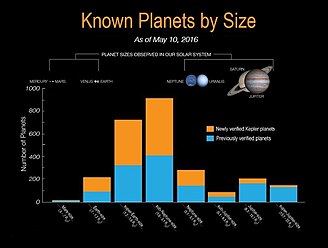
An exoplanet or extrasolar planet is a planet outside the Solar System. The first possible evidence of an exoplanet was noted in 1917 but was not then recognized as such. The first confirmation of the detection occurred in 1992. A different planet, first detected in 1988, was confirmed in 2003. As of 1 May 2024, there are 5,662 confirmed exoplanets in 4,169 planetary systems, with 896 systems having more than one planet. The James Webb Space Telescope (JWST) is expected to discover more exoplanets, and to give more insight into their traits, such as their composition, environmental conditions, and potential for life.
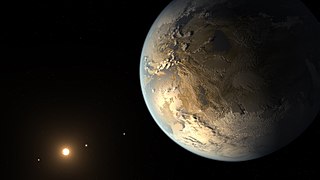
These are lists of planets. A planet is a large, rounded astronomical body that is neither a star nor its remnant. The best available theory of planet formation is the nebular hypothesis, which posits that an interstellar cloud collapses out of a nebula to create a young protostar orbited by a protoplanetary disk. There are eight planets within the Solar System; planets outside of the solar system are also known as exoplanets.
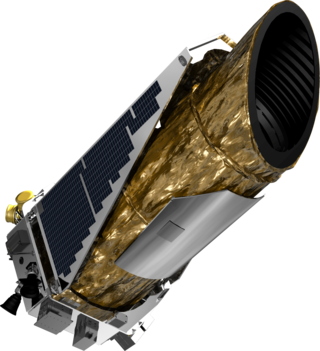
The Kepler space telescope is a defunct space telescope launched by NASA in 2009 to discover Earth-sized planets orbiting other stars. Named after astronomer Johannes Kepler, the spacecraft was launched into an Earth-trailing heliocentric orbit. The principal investigator was William J. Borucki. After nine and a half years of operation, the telescope's reaction control system fuel was depleted, and NASA announced its retirement on October 30, 2018.
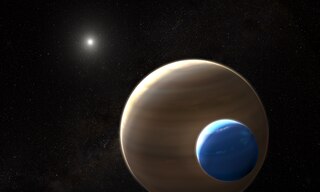
An exomoon or extrasolar moon is a natural satellite that orbits an exoplanet or other non-stellar extrasolar body.

A Super-Earth is a type of exoplanet with a mass higher than Earth's, but substantially below those of the Solar System's ice giants, Uranus and Neptune, which are 14.5 and 17 times Earth's, respectively. The term "super-Earth" refers only to the mass of the planet, and so does not imply anything about the surface conditions or habitability. The alternative term "gas dwarfs" may be more accurate for those at the higher end of the mass scale, although "mini-Neptunes" is a more common term.

An exoplanet is a planet located outside the Solar System. The first evidence of an exoplanet was noted as early as 1917, but was not recognized as such until 2016; no planet discovery has yet come from that evidence. What turned out to be the first detection of an exoplanet was published among a list of possible candidates in 1988, though not confirmed until 2003. The first confirmed detection came in 1992, with the discovery of terrestrial-mass planets orbiting the pulsar PSR B1257+12. The first confirmation of an exoplanet orbiting a main-sequence star was made in 1995, when a giant planet was found in a four-day orbit around the nearby star 51 Pegasi. Some exoplanets have been imaged directly by telescopes, but the vast majority have been detected through indirect methods, such as the transit method and the radial-velocity method. As of 1 May 2024, there are 5,662 confirmed exoplanets in 4,169 planetary systems, with 896 systems having more than one planet. This is a list of the most notable discoveries.
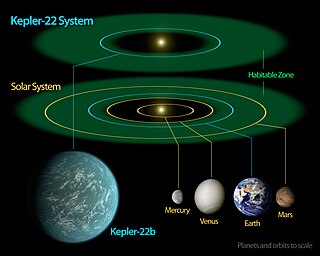
Kepler-22b is an exoplanet orbiting within the habitable zone of the Sun-like star Kepler-22. It is located about 640 light-years from Earth in the constellation of Cygnus. It was discovered by NASA's Kepler Space Telescope in December 2011 and was the first known transiting planet to orbit within the habitable zone of a Sun-like star, where liquid water could exist on the planet's surface. Kepler-22 is too dim to be seen with the naked eye.
Kepler-47 is a binary star system in the constellation Cygnus located about 3,420 light-years away from Earth. The stars have three exoplanets, all of which orbit both stars at the same time, making this a circumbinary system. The first two planets announced are designated Kepler-47b, and Kepler-47c, and the third, later discovery is Kepler-47d. Kepler-47 is the first circumbinary multi-planet system discovered by the Kepler mission. The outermost of the planets is a gas giant orbiting within the habitable zone of the stars. Because most stars are binary, the discovery that multi-planet systems can form in such a system has impacted previous theories of planetary formation.

Kepler-69c is a confirmed super-Earth extrasolar planet, likely rocky, orbiting the Sun-like star Kepler-69, the outermore of two such planets discovered by NASA's Kepler spacecraft. It is located about 2,430 light-years from Earth.

Kepler-62 is a K-type main sequence star cooler and smaller than the Sun, located roughly 980 light-years from Earth in the constellation Lyra. It resides within the field of vision of the Kepler spacecraft, the satellite that NASA's Kepler Mission used to detect planets that may be transiting their stars. On April 18, 2013, it was announced that the star has five planets, two of which, Kepler-62e and Kepler-62f are within the star's habitable zone. The outermost, Kepler-62f, is likely a rocky planet.

Kepler-62e is a super-Earth exoplanet discovered orbiting within the habitable zone of Kepler-62, the second outermost of five such planets discovered by NASA's Kepler spacecraft. Kepler-62e is located about 990 light-years from Earth in the constellation of Lyra. The exoplanet was found using the transit method, in which the dimming effect that a planet causes as it crosses in front of its star is measured. Kepler-62e may be a terrestrial or ocean-covered planet; it lies in the inner part of its host star's habitable zone.

Kepler-69 is a G-type main-sequence star similar to the Sun in the constellation Cygnus, located about 2,390 ly (730 pc) from Earth. On April 18, 2013 it was announced that the star has two planets. Although initial estimates indicated that the terrestrial planet Kepler-69c might be within the star's habitable zone, further analysis showed that the planet very likely is interior to the habitable zone and is far more analogous to Venus than to Earth and thus completely inhospitable.
Kepler-61 is a K-type main-sequence star approximately 1,100 light years from Earth in the constellation Cygnus. It is located within the field of vision of the Kepler spacecraft, the satellite that NASA's Kepler Mission used to detect planets that may be transiting their stars. On April 24, 2013 it was announced that the star has an extrasolar planet orbiting in the inner edge of the habitable zone, named Kepler-61b.

Kepler-438b is a confirmed near-Earth-sized exoplanet. It is likely rocky. It orbits on the inner edge of the habitable zone of a red dwarf, Kepler-438, about 472.9 light-years from Earth in the constellation Lyra. It receives 1.4 times our solar flux. The planet was discovered by NASA's Kepler spacecraft using the transit method, in which the dimming effect that a planet causes as it crosses in front of its star is measured. NASA announced the confirmation of the exoplanet on 6 January 2015.

Kepler-442b is a confirmed near-Earth-sized exoplanet, likely rocky, orbiting within the habitable zone of the K-type main-sequence star Kepler-442, about 1,206 light-years (370 pc) from Earth in the constellation of Lyra.
Kepler-296f is a confirmed super-Earth exoplanet orbiting within the habitable zone of Kepler-296. The planet was discovered by NASA's Kepler spacecraft using the transit method, in which the dimming effect that a planet causes as it crosses in front of its star is measured. NASA announced the discovery of the exoplanet on 26 February 2014.

Kepler-452b is a super-Earth exoplanet orbiting within the inner edge of the habitable zone of the sun-like star Kepler-452 and is the only planet in the system discovered by Kepler. It is located about 1,400 light-years (430 pc) from Earth in the constellation of Cygnus.

Kepler-452 is a G-type main-sequence star located about 1,810 light-years away from Earth in the Cygnus constellation. Although similar in temperature to the Sun, it is 20% brighter, 3.7% more massive and 11% larger. Alongside this, the star is approximately six billion years old and possesses a high metallicity.
Kepler-1229 is a red dwarf star located about 875 light-years (268 pc) away from the Earth in the constellation of Cygnus. It is known to host a super-Earth exoplanet within its habitable zone, Kepler-1229b, which was discovered in 2016.
K2-155d is a potentially habitable Super-Earth exoplanet in the K2-155 system. It is the outermost of three known planets orbiting around the K-type star K2-155 in the constellation Taurus. It is one of 15 new exoplanets around red dwarf stars discovered by Japanese astronomer Teruyuki Hirano of the Tokyo Institute of Technology and his team. The team used data from NASA's Kepler Space Telescope during its extended K2 "Second Light" mission. K2-155d orbits near the so-called habitable zone of its system, and has the potential to host liquid water.

